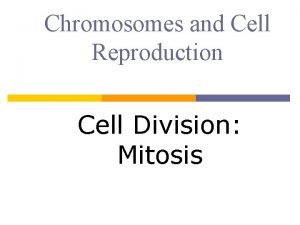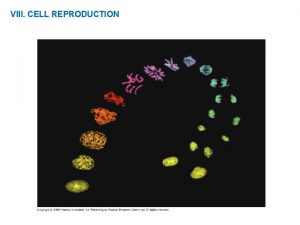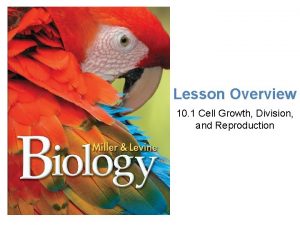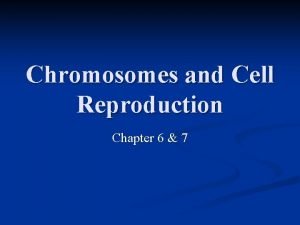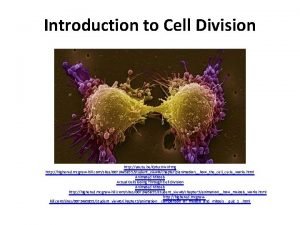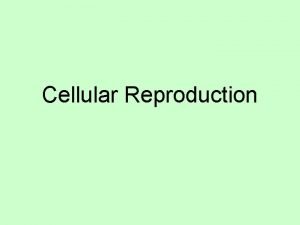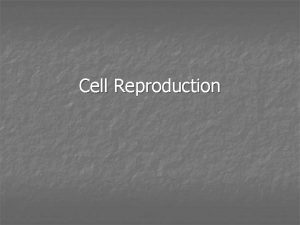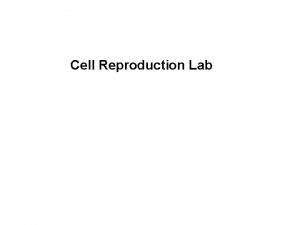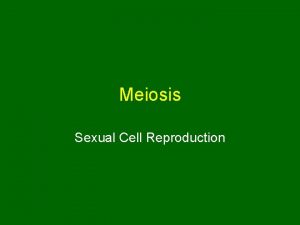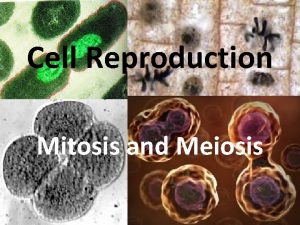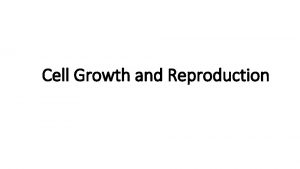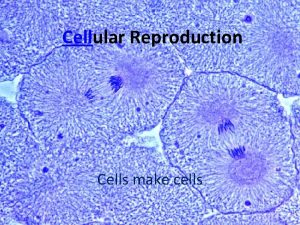Cell Reproduction How do cells make new cells



























- Slides: 27

Cell Reproduction How do cells make new cells?

Cell Reproduction • Reproduce: process by which living things give rise to other living things – Two Types of Cell Reproduction • Asexual: one parent offspring is identical • Sexual: two parents offspring is not identical

Types of Asexual Reproduction • Binary Fission – Primary way that bacteria (unicellular) cells reproduce

Budding • Usually seen in yeast cells • Cell replicates when a piece of the cell pinches off and separates from the parent cell

Spore • Found in fungi, algae, protozoa • Airborne cells that are released from the parent. They are enclosed and developed when the environment is appropriate

Regeneration • Ability to re-grow lost parts • Found in starfish, earthworms, some reptiles

Vegetative Propagation • Regeneration in plants from an area that is remaining

Mitosis • The process where animal cells divide • This is a type of asexual reproduction • Body cells (somatic cells) go through the process of mitosis

Sexual Reproduction in cells • Meiosis – Process where sex cells are made in the gonads • Gonads organs where sex cells are made – Male testes make and house sperm – Females ovaries make and house eggs We will discuss meiosis later!!!!

Cell Cycle • Why is the cell cycle called a cycle? • Why do you think it’s important for a cell to grow in size during its cell cycle?

Cell Cycle- The Cell’s Timeclock

What happens in each stage cell reproduction?

Interphase: not part of mitosis • Interphase-(technically not part of mitosis, but it is included in the cell cycle) • Cell is in a resting phase, performing cell functions • DNA replicates (copies) • Organelles double in number, to prepare for division – G 1 - First growth – S - synthesis (copy DNA) – G 2 - Second growth

Process of Mitosis


Prophase • • Spindle forms Centrioles move to opposite poles Chromosomes become visible Nuclear membrane breaks down in prometaphase

Metaphase • Chromosomes line up along the equator

Anaphase • Centromeres divide • Chromatids separate and move to opposite poles

Telophase • Nuclear membrane forms around each group of chromosomes • Chromosomes unwind, nuclear membrane forms again

Cytokinesis begins • Cell pinches inward and forms two daughter cells



Visit Biology Corner • www. biologycorner. com Click on the images link on the top Scroll on the right hand side where the animations section is then scroll down to cells and look for any animation on mitosis to look at

Results of Mitosis • Same number of chromosomes from generation to generation (46 in humans) • Each daughter cell (offspring) gets exact copy of chromosomes

Consequences of Incorrect Mitosis • Cancer: uncontrolled mitotic division in cells – Timeclock does not work properly

Plant Mitosis • Same process as in animal cell but plants don’t have the centrioles

Uses for Mitosis • Replicate young embryonic cells • Replicate body (somatic) cells. Skin, blood cells • Repair damaged cells • Controls cell growth and death. – Cytokinins: chemicals that regulate cell replicating
 Chapter 8 cellular reproduction cells from cells
Chapter 8 cellular reproduction cells from cells The disadvantages of sexual reproduction
The disadvantages of sexual reproduction Hare lynx
Hare lynx Venn diagram of sexual and asexual reproduction in animals
Venn diagram of sexual and asexual reproduction in animals Cell reproduction
Cell reproduction Mitosis sexual reproduction
Mitosis sexual reproduction Cell of reproduction
Cell of reproduction Cell reproduction
Cell reproduction Cell growth division and reproduction
Cell growth division and reproduction Chapter 6 chromosomes and cell reproduction
Chapter 6 chromosomes and cell reproduction Development of paranasal sinuses
Development of paranasal sinuses Tubular reabsorption
Tubular reabsorption Pineal gland
Pineal gland Haploid and diploid venn diagram
Haploid and diploid venn diagram Somatic cells vs germ cells
Somatic cells vs germ cells Red blood cells and white blood cells difference
Red blood cells and white blood cells difference Prokaryotic vs eukaryotic cells
Prokaryotic vs eukaryotic cells Animal rights and animal welfare venn diagram
Animal rights and animal welfare venn diagram Prokaryotes vs eukaryotes venn diagram
Prokaryotes vs eukaryotes venn diagram Cell organelle jeopardy
Cell organelle jeopardy Masses of cells form and steal nutrients from healthy cells
Masses of cells form and steal nutrients from healthy cells Label
Label What cell type
What cell type Prokaryotic cell wall
Prokaryotic cell wall Cell substance
Cell substance Mitosis phases
Mitosis phases What do cells make up
What do cells make up Make the lie big, make it simple
Make the lie big, make it simple




